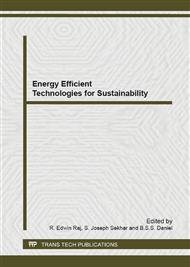[1]
TERI, National Energy Map for India, TERI, (2006).
Google Scholar
[2]
I. Singh and A. Michaelowa, Indian Urban Building Sector: CDM Potential through Energy Efficiency in electricity consumption, in HWWA Hamburg Institute of International Economics, Hamburg, (2004).
DOI: 10.2139/ssrn.576001
Google Scholar
[3]
B. Reddy, Economic and Social dimensions of household energy use: A case study of India, Advances in Energy Studies, (2004) 469-477.
Google Scholar
[4]
S. Pachauri, An analysis of cross-sectional variations in total household energy requirements in India using micro survey data, Energy Policy, (2004) 1723-1735.
DOI: 10.1016/s0301-4215(03)00162-9
Google Scholar
[5]
J. Roy, The rebound effect: some empirical evidence from India, Energy Policy, (2000) 433-438.
DOI: 10.1016/s0301-4215(00)00027-6
Google Scholar
[6]
Reddy, B. Sudhakara; Srinivas, T., Energy use in Indian household sector - An actor-oriented approach, Energy, (2009) 992-1002.
DOI: 10.1016/j.energy.2009.01.004
Google Scholar
[7]
L. Suganthi and A. A. Samuel, Energy models for demand forecasting - A review, Renewable and Sustainable Energy Reviews, 16 (2012) 1223-1240.
DOI: 10.1016/j.rser.2011.08.014
Google Scholar
[8]
http: /www. worldenergyoutlook. org/media/weowebsite/2008-1994/WEO_2007. pdf. [Accessed 15 January 2012].
Google Scholar
[9]
V. L. Pandey and A. Chaubal, Comprehending household cooking energy choice in rural India, Biomass and Bioenergy, 35 (2011) 4724-4731.
DOI: 10.1016/j.biombioe.2011.09.020
Google Scholar
[10]
S. Gangopadhyay, B. Ramaswami and W. Wadhwa, Reducing subsidies on household fuels in India: how will it affect the poor?, Energy Policy, 33, 18 (2005) 2326-2336.
DOI: 10.1016/j.enpol.2004.04.024
Google Scholar
[11]
I. H. Rehman, P. Malhotra, R. C. Pal and P. B. Singh, Availability of Kerosene to rural households: A case study from India, Energy Policy, 33, 17 (2005) 2165-2174.
DOI: 10.1016/j.enpol.2004.04.014
Google Scholar
[12]
P. Balachandra and G. L. Shekar, Energy technology portfolio analysis: an example of ligthing for residential sector, Elsevire Energy Conversion & Management, 42 (2001) 813-832.
DOI: 10.1016/s0196-8904(00)00103-5
Google Scholar
[13]
S. Mahapatra, H. Chanakya and S. Dasappa, Evaluation of various energy devices for domestic lighting in Inida: Technology, economics and CO2 emissions, Energy for Sustainable Development, 13 (2009) 271-279.
DOI: 10.1016/j.esd.2009.10.005
Google Scholar
[14]
B. S. Reddy and T. Srinivas, Energy use in Indian household sector- An actor oriented approach, Energy, 34 (2009) 992-1002.
DOI: 10.1016/j.energy.2009.01.004
Google Scholar
[15]
B. S. Reddy, P. Balachandra and H. S. K. Nathan, Universalization of access to modern energy services in indian households - Economic and policy analysis, Energy Policy, 37 (2009) 4645-4657.
DOI: 10.1016/j.enpol.2009.06.021
Google Scholar
[16]
T. W. Bank, Residential Consumption of Electricity in India, The World Bank, (2008).
Google Scholar
[17]
MoEF, India, Second National Communication to UNFCCC, Ministry of Environment & Forests, (2012).
Google Scholar
[18]
S. Sharma, S. Bhattacharya and A. Garg, Greenhouse gas emission from India: A perspective, Current science, 90 (2006) 3.
Google Scholar
[19]
I. Statistics, CO2 Emissions from fuel combustion, International Energy Agency, (2010).
Google Scholar
[20]
Antonette D'Sa and K.V. Narasimha Murthy, LPG as a cooking fuel option for India, Energy and Sustainable Development, 8, 3 (2004) 91-106.
DOI: 10.1016/s0973-0826(08)60471-8
Google Scholar


